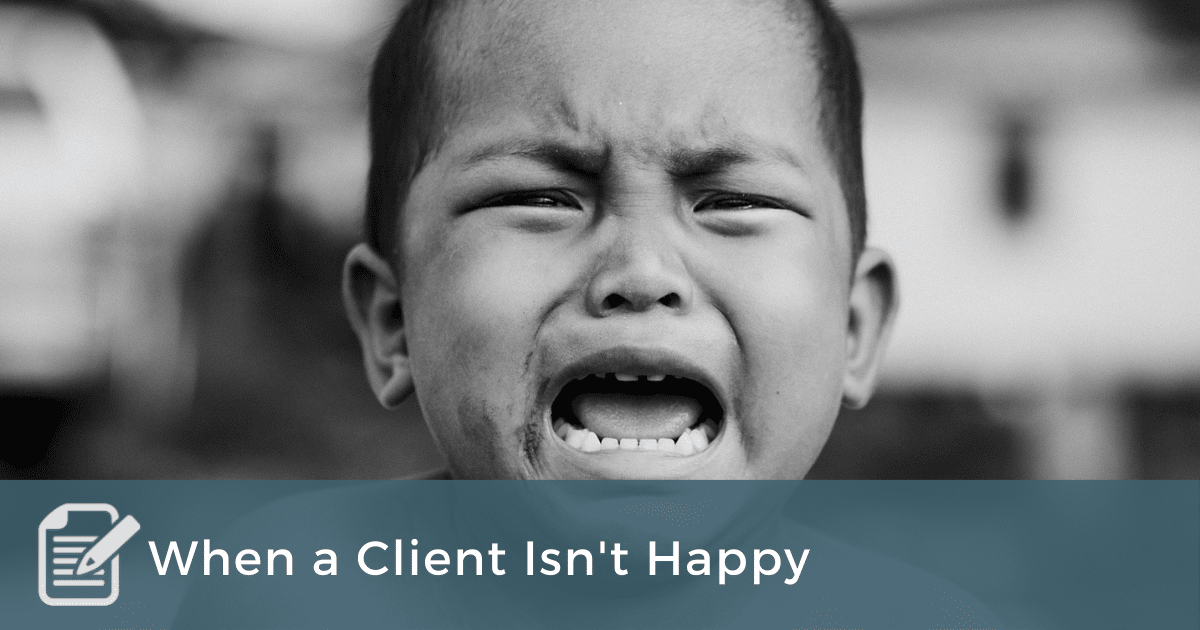
The coach who thinks he is going to skate through the profession without ever having an unhappy client will eventually be disappointed. There is nothing magic or holy about coaching that prevents the occasionally unhappy client. And I suppose even magicians and priests encounter an unhappy person every now and then. Since each of us is going to have clients who are dissatisfied, displeased, disappointed, or otherwise unhappy, what’s a coach to do when the inevitable happens?
Let’s examine six elements that need to be considered when we have an unhappy client.
- Client First. The mantra of the great coach is that the client always comes first. We put the needs of the client high on our priority and we always strive to be of helpful service to those we coach. An unhappy client should never be the result of the coach putting the coach’s needs ahead of the client.
I once heard of a novice coach who would conduct coaching calls in his car while running errands. He had to take care of his errands, so he figured he could kill two birds with one stone. As you can imagine, some of his clients were not pleased that they were paying for his time and getting only some of his attention.
When you have an unhappy client, do an honest gut check to make sure it’s not because you’ve somehow (even unknowingly) put the client second. - Expectations. Often an unhappy client is the result of conflicting expectations – the client expects something from the coach or a result from the coaching relationship that is outside the bounds of what the coach expects.
An expectations mismatch usually stems from a lack of diligence in the early stages of the coaching relationship. It’s the responsibility of the coach and client to co-create the relationship in a way that establishes mutual expectations, but this doesn’t always happen. Sometimes the coach fails to clearly share how coaching works or get agreement from the client. Other times the client isn’t paying attention or doesn’t engage the agreement process fully enough to ask clarifying questions. Coaches who assume their client knows how coaching works will be disappointed. Clients who assume the coaching will go according to their unspoken expectations will be unhappy.
When expectations are misaligned, re-create the relationship, if possible. Clarify with the client how coaching works, the need for the client to do most of the heavy lifting, and the facilitative nature of coaching. - Mismatch. Sometimes a coach-client mismatch doesn’t reveal itself until well into the coaching relationship. It’s better if it’s revealed in the contracting phase, and we should do our due diligence to make sure there’s enough of a match in terms of things like chemistry, worldview, expectations, and style before diving into the coaching. However, sometimes we get several sessions into a coaching relationship only to realize that something is not clicking.
Professional coaches are adaptive to many kinds of clients and typically we can make adjustments to help create more of a match. But there are some clients you are simply not going to connect with, for whatever reason. This doesn’t mean either of you is a bad person or something’s wrong with someone, it’s just the way humans are. - Referral. Hopefully a client can go from unhappy to happy with the right kind of attention and conversation from the coach. But sometimes resolution isn’t possible, and the coaching arrangement needs to end. When that happens, the coach needs to offer a referral.
I once had a client who wanted way more advice and instruction than was my style. After three sessions, he’d grown frustrated. We talked it through and I shared with him how in the agreement phase we’d discussed that I wasn’t going to give him answers or tell him what to do. He acknowledged this and declared that he wanted a style of coaching that would be more 50/50 coaching and training. I shared with him the names of three coaches who likely could help him and made introductions. Of course I was disappointed the coaching relationship ended, but I was still able to put the client first by referring him to someone who could provide the kind of service he wanted. - Growth. An unhappy client is often a source of feedback for the coach. And feedback, even when it’s off-base, brings an opportunity for growth. When a client is unhappy, invite them to share openly with you. Receive what they share without defense. And remember, receiving feedback is not the same thing as agreeing with the feedback. Often it’s necessary to ponder a piece of feedback and to consider it over several days before discerning its validity.
I don’t know about you, but I’d rather grow stronger as a coach as a result of doing a great job and pleasing my clients. That’s the kind of growth that feels good! But if we’re going to put our clients first, we must be eager to grow from our struggles, not just our successes. - Confidence. An unhappy client is going to happen from time to time. Don’t let the occasional unhappy client dissolve your confidence. Confidence is one of the most important ingredients in bringing your best to coaching. As I like to say, confidence is the dimmer switch on your competence (ability). Work to keep your confidence appropriately high, even when things don’t go well.
Professional athletes are incredibly good at what they do. And they work hard on the mental side of things because they know athletic performance is greatly influenced by what’s happening in their thoughts and feelings. The same is true with coaches. If we allow an occasional misfire to rob us of our confidence, our performance will suffer and so will our clients.
When was the last time you had an unhappy client? What was the reason? What do you wish you had done differently? How did you grow from the experience?


